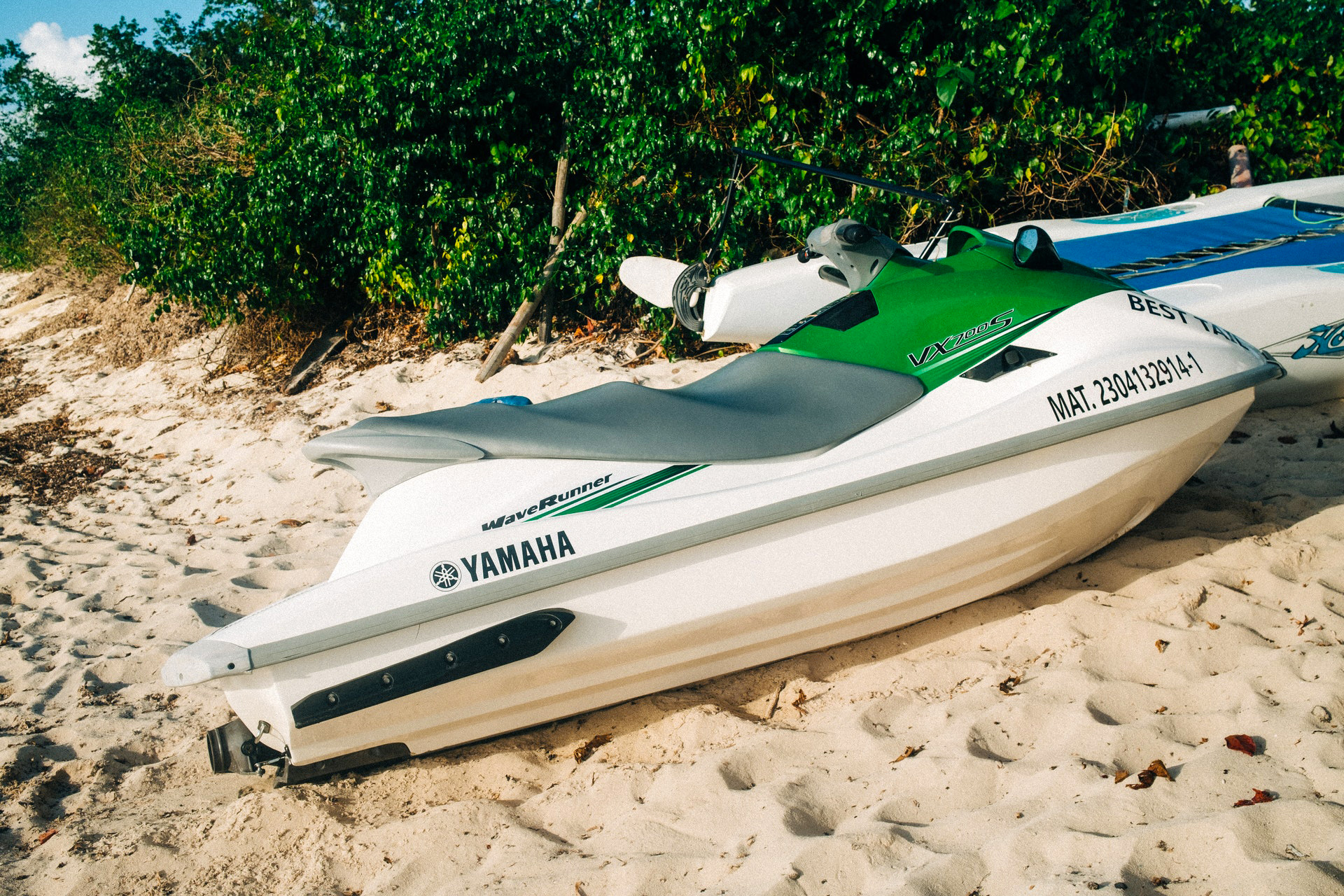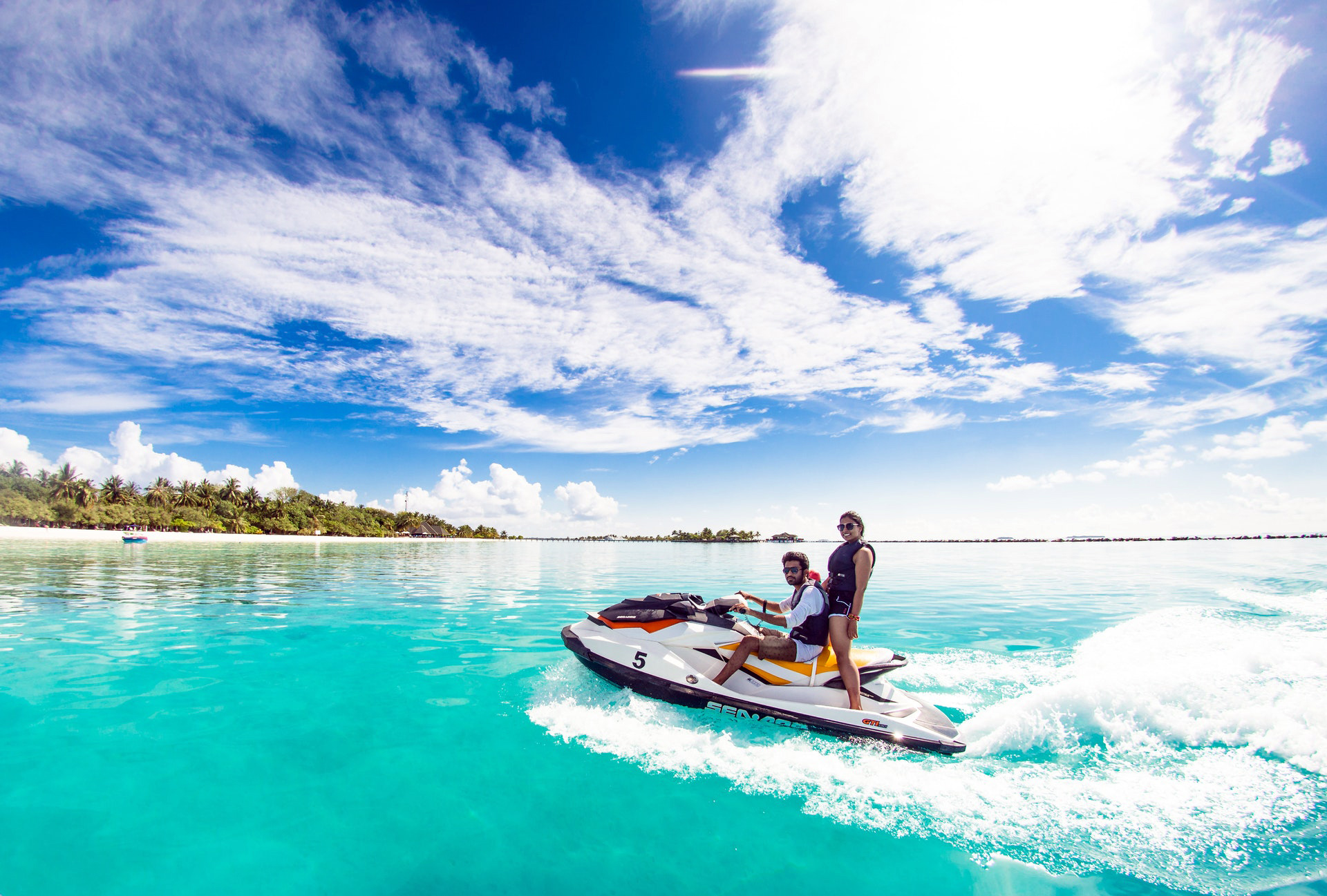Do you wish to own a personal watercraft like a jet ski to ride on the beach near your house? Or, do you want to have a personal watercraft to take on beach vacations whenever you get the chance?
Whatever your interest may be in different types of jet skis and the jet skiing activity itself, you can always rent and purchase a jet ski as per your requirements. Of course, some people are still young at heart, while others only want to spend their free time vacationing on their favorite beach.
Jet Skiing is one of the best water sports activities (such as paddle boarding) with thousands of enthusiasts across the world. Every year, people pick the most suitable Jet Ski rentals around them to learn jet ski or have some fun. But this year, you don’t have to go empty-handed. This short post will provide you with some basic information about jet skis and how they work.
What is a Jet Ski?

The specifics of jet skis are quite broad. It’s safe to say that talking about a specific model from a specific brand will take up a lot of space in this post and your time.
Instead, we will stick to general information that will help all jet ski noobs understand the water vehicle with ease.
Previously, Jet Ski was a term known for Kawasaki’s water vehicle brand.
The brand was manufacturing personal watercraft for people who loved surfing on the oceans and sea. Although the term erupted specifically from Kawasaki and their brand, it’s widely used to refer to a personal watercraft that’s small, and the rider sits on the top of, much like a motorcycle on the road. There are different types of jet skis that we will get to later in this article.
While Jet Ski was a Kawasaki-specific term, Yamaha’s personal watercraft that fulfilled the same purpose with varying specifications was called the WaveRunner. The brand only manufactured stand-up WaveRunners for closed-course competitions.
Jet Skis are a type of small watercraft that operates like motorcycles but on the water.
They have an engine built inside the hull. And usually, the rider’s/driver’s seat is right on top of the hull. Jet Skis have handles like motorcycles that assist in accelerating, braking, and steering. The personal watercraft/ Jet Ski has a bench seat to help the rider sit on top of it rather than in it.
How Much Does a Jet Ski Weigh
Renting a Jet Ski isn’t a bad idea as long you know how a Jet Ski works. For most people, a full-day Jet Ski tour around their favorite beach is a dream come true. However, riding a Jet Ski isn’t so easy, especially if it’s your first time. You must have basic information about the personal watercraft, such as how to drive a Jet Ski, how much does a Jet Ski weigh, and how fast do Jet Skis usually go.
For your information, a jet ski’s weight isn’t consistent and can vary depending on the manufacturing, models, and modifications.
On average, the weight of a Jet Ski is around 300-950 pounds.
Again, the make and model will have a huge impact on the net weight of a typical Jet Ski used for recreational or performance purposes. Apart from the dry weight (net weight) right off the manufacturing plant, you can assume that the weight of a Jet Ski will probably be around 350-1200 pounds after gear, oil, and/or gas change.
How Long is a Jet Ski?
How long is a Jet Ski? Knowing this can give you a good idea about how much practice you need before you can master riding the personal watercraft. Of course, every 14 years-old wants to race along the waves, but that doesn’t mean that they should unless they’re fully trained and equipped with the necessary skills.
So, how long is it? Well, a typical sit-down Jet Ski can be as long as 120 inches. Considering that length, the width can be 45 inches to 50 inches.
Stand-up personal watercrafts are 80 inches to 100 inches long with 25 inches to 30 inches in width.
For Kawasaki in general, the length can be between 100 inches and 130 inches, depending on the make and model.
How Fast Do Jet Skis Go?
Every water sports lover dreams of riding the fastest jet ski at least once in their lifetime. Some people are so passionate about Jet Skiing that they even buy a personal watercraft for themselves.
Speeding up a Jet Ski and racing alongside sea waves can be truly thrilling for an adventure-seeker. But, make sure you know about the boating laws in the region before you start Jet Skiing at max speed. Plus, you must have a fuel-efficient Jet Ski to avoid high fuel costs.
Jet Ski rental professionals and other experts, as well as coast guards agree that a Jet Ski can’t go over the speed of 70 miles per hour.
In contrast, the average speed ratio of a typical Jet Ski ranges from 40 mph to 70 mph.
We also recommend that you read the article: “Are Jet Skis Dangerous? Common Jet Ski Problems“.
Is a Jet Ski a Boat?
For your information, Jet Skis are small boats that allow drivers/riders to sit on top of them using a bench seat attached directly to the hull’s main. Sometimes, a Jet Ski maybe stand-up, which means that the seating space may not be as adequate, but such adventure-seekers don’t really care about it either.
A personal watercraft, known as a small vessel, has an inboard jet drive, which is the primary source of propulsion. The water vehicle is designed for riders to sit, stand, or kneel on it. It can also accommodate one or more persons depending on the size and length of the Jet Ski.
If you’re thinking about whether a Jet Ski is a boat, the answer is “no.” That’s because, in a boat, drivers/riders and passengers sit within the space provided as part of the hull.
For instance, there’s ample space in the middle section of a boat. But for a Jet Ski/ personal watercraft, the space is provided as a bench seat on top of the hull. In simple words, riders don’t sit within a Jet Ski but rather on top of it. That’s why it’s not a boat.
Types of Jet Skis

Are you wondering about all the types of Jet Skis there are and which one can suit your needs better?
Well, don’t worry because we have you covered here. Here’s a list of the top-most important types of Jet Skis manufactured and used for surfing the waves.
Recreational-Light Jet Ski
These are the most lightweight, light-performance, and affordable types of Jet Skis. Owning a recreational-light personal watercraft allows you to enjoy Jet Skiing adventures comfortably as a beginner. Some rec-light Jet Skis often support two passengers.
Recreational Jet Ski
Faster and bigger than recreational-light Jet Skis, recreational Jet Skis are also affordable and slightly mid-range models.
They typically have more options, features, and performance traits. They can often go over a top speed of 50-65 mph.
Performance Jet Ski
Going over 70-80 mph, performance Jet Skis are the elite version recreational Jet Skis manufactured for skilled professionals. They’re frequently used in competitions and close circuit racing.
They have powerful engines and are usually among the fastest jet ski types out there that support only one passenger but may offer comfortable seating for two.
Stand-up Jet Ski
Stand-up Jet Ski models are more like a fashion trend in the personal watercraft industry. Buying a stand-up Jet Ski is quite tricky as they’re rare and mostly used for closed course competitions by professionals.
Luxury Jet Ski
As the name suggests, these are top-of-the-shelf Jet Skis designed for the ultimate Jet Skiing experience. With above-average performance, luxury Jet Skis are all about comfort and power.
Although their primary focus is on design, features, options, and comfort, some luxury Jet Skis can have a horsepower well beyond 300!
How Does a Jet Ski Work?
Jet Skis are quite simple machines, and their working mechanisms are far more comprehensible. Just like how car wheels exert force onto the ground (pull on the ground) to move forward, the jet propulsion engine of a Jet Ski has a similar responsibility. It’s one of the most important parts of a Jet Ski.
A typical Jet Ski engine pulls water in and then pushes it back with force to move the Jet Ski forward. The force of taking the water inside the engine isn’t as significant as the force of propulsion with which the Jet Ski pushes the water out to move forward. The harder the engine pushes the water out, the faster the Jet Ski will move ahead.
You can think of it as swimming, climbing, or even driving a sedan on a highway. It involves a pull and pushes mechanism to drive the Jet Ski forward in the water. It’s as simple as that!
How to Ride a Jet Ski? /How to Drive a Jet Ski?

Place both hands on the handlebars firmly and find a good grip while taking a comfortable seat on the hull of your chosen Jet Ski. Have a solid grip on the footrests of the Jet Ski (wear water shoes for better performance).
As you turn the ignition switch, start pushing the throttle slowly. Keep a low speed around 5-8 mph to get clear of all obstacles and shorelines.
To change directions, lean towards the angle you want to head to while turning the handlebars in that direction firmly.
The maneuver must be swift to avoid losing grip and to maintain a consistent throttle. You can ride well when you have a Jet Ski captain behind you during your first few times.
Do You Need a License to Drive a Jet Ski?
It’s a simple question that nearly every Jet Ski rider may ask. To help you make the right decision, we would recommend that you get your boating license. This way, you avoid getting fined or penalized for Jet Skiing in public waters without a license.
Over 40 states in America require you to have a boating license if you plan to operate a WaveRunner, personal watercraft, or Jet Ski. Getting a license is pocket-friendly, and you have to go through several educational classes to obtain it. The classes and license generation criteria are under the direct authority of the National association of state boating law administrators.
Some professionals and experts also refer to the license as a boater safety course certificate or boater education course certificate.
The license helps the coast guard ensure that you have the minimum skills to operate a Jet Ski on your own in any of the respective 40 states that require you to have a license in the first place.
What is the Legal Age to Drive a Jet Ski?
One of the first questions that many Jet Ski-enthusiasts ask is, “what is the age to drive a Jet Ski.” Well, it depends on state laws and the governing/authoritative standards set forth by the National association of state boating law administrators.
The authorities have set the minimum age to operate a Jet Ski, personal watercraft, or WaveRunner at 16 years.
Whether you’re 16 or above, you must follow all the safety requirements and meet all the necessary criteria to obtain your license and get on top of a Jet Ski.
How Much to Rent a Jet Ski?
Renting a Jet Ski is quite easy. Make sure to do some research about the top-rated and reviewed Jet Ski rentals near you or where you’re planning to go.
In some places, half-hour rates can be as low as $60, and full-hour rates can be as high as $90.
What to Wear Jet Skiing?
Jet Skis are designed in such a way that they remain afloat on the water, provided there’s no damage to the exterior of the vessel. It’s cumbersome to flip a personal watercraft as well, so you don’t have to worry about it turning over.
Altogether, only the Jet Skis that pass the safety threshold is released into the market by the manufacturers, so you don’t have to worry about the quality when purchasing one.
However, you can check and inspect the quality of a Jet Ski when you’re renting one. Learning how to ride a Jet Ski isn’t difficult if you have the right guide by your side. So, what safety equipment do you need on a Jet Ski, and how can you ride it safely? Find out below!
What Safety Equipment is Required on a Jet Ski?
- Make sure you’re wearing a proper bathing suit because you will be in the water. Water rash is much more uncomfortable than it sounds!
- Wearing goggles can protect your eyes from saltwater rashes that most inexperienced Jet Skiing enthusiasts are vulnerable to.
- Don’t forget to wear a bathing suit of proper size along with water shoes to have a solid grip on the Jet Ski you’re operating.
- Remember that you will always need life jackets as a safety measure in case of an emergency or Jet Ski malfunctions. Life jackets can keep you afloat on the water until emergency personnel arrives.
- Always hit the max speed when you’re a safe distance from public or any solid surface like beach, islands, huts, and more. It’s not hard to crash into something when you’re operating your personal watercraft at max speed.
Conclusion
Make sure that you learn about the state boating laws where you plan to operate your Jet Ski. It can be fun to have a Jet Ski trip with your friends and family once in a while.
However, no one likes to get in trouble with the water patrol, so wearing safety equipment and carrying a boating license can be a lifesaver.
You must be of minimum age with all safety equipment right beside you at all times, whether you’re renting a Jet Ski or driving your personal watercraft to the beach.
